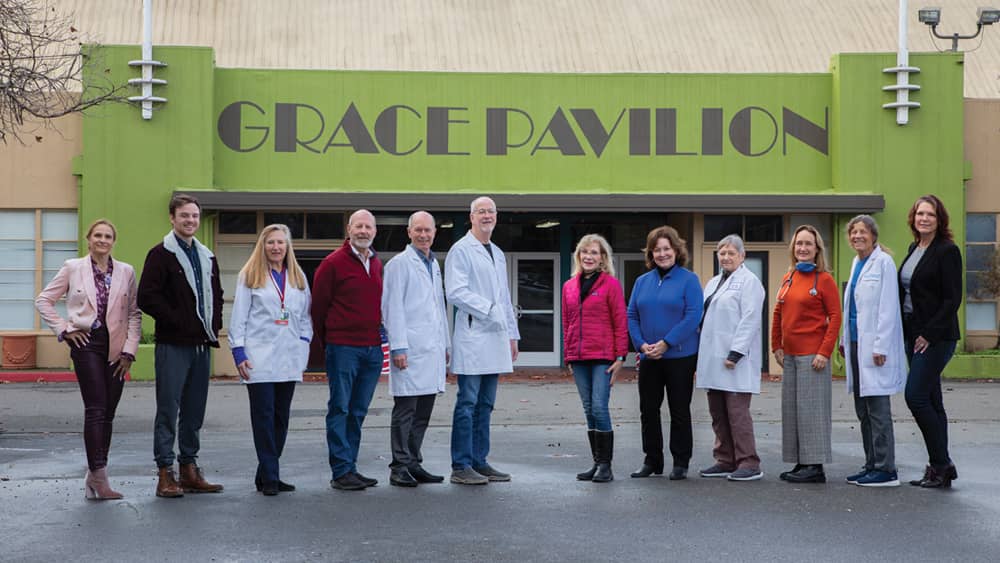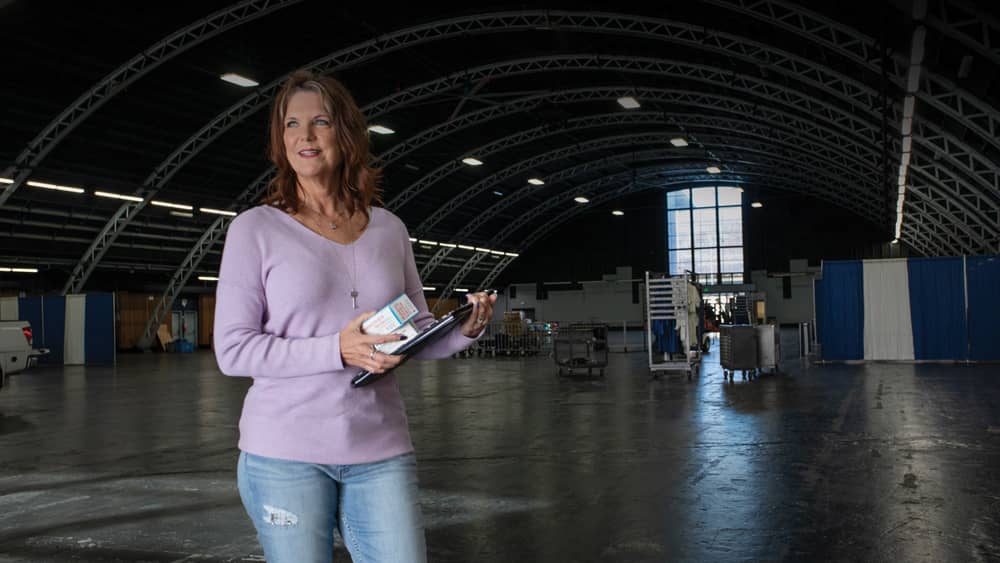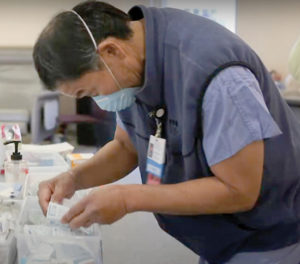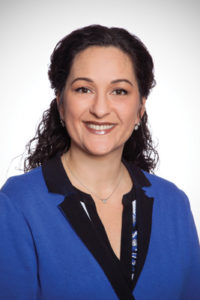
From left, Rachel Pandolfi, Brenden Caskey, Loie Saur, M.d., Steve Olson, M.d., Patrick Leoni, M.d., Patrick Caskey, M.d., Kate Black, M.d., Nancy doyle, M.d., Jean Cool, M.d., Jill Zechowy, M.d., Garima Hoffman, M.d. and Wendy Young, executive director. [duncan Garrett Photography]
In January 2021, the Sonoma-Mendocino-Lake Medical Association took on an unprecedented role in organizing vaccine drives for healthcare professionals and later, for the general public. Hundreds of members who were healthcare professionals volunteered to give shots. One individual was instrumental in ensuring the drives were safe and welcoming, Executive Director Wendy Young.
“When the vaccine became widely available, our role shifted from protecting physicians to helping everyone. Between January 2021 and August 2021, we vaccinated almost 36,000 people. All of the volunteers, businesses and nonprofits that helped were fantastic,” says Young. “They demonstrated collaboration and care by coming together for a common cause during the pandemic.”
Young says the Sonoma-Mendocino-Lake Medical Association (SMLMA) learned a great deal from mobilizing quickly and partnering with numerous entities, including the Sonoma County Department of Health Services, Santa Rosa Community Health, Sonoma County Vintners, Sonoma County Winegrowers and Exchange Bank. SMLMA also collaborated with Catholic Charities, COTS and other organizations that serve people experiencing homelessness, as well as a plethora of local businesses from Bear Republic Brewery and Mountain Mike’s. “In August 2021, when the demand for vaccines tapered off. SMLMA halted vaccine clinics to allow patients to visit other established clinics or their physicians,” says Young. “We are prepared to step up again if needed. We have a playbook on how to handle a widespread public health emergency. We’re also prepared to mobilize during wildfires and evacuations if needed.”

The beginning
SMLMA opened its first vaccination clinic at 3313 Chanate Rd. in Santa Rosa in January last year after the U.S. Food and Drug Administration approved the Pfizer vaccine. “We started this effort by sending an email directly to doctors and their medical staff. The email went viral,” says Young. “We had 500 appointments booked in less than four hours. We reached out to the Sonoma County Department of Health Services who gave the go-ahead to vaccinate those who were able to schedule appointments.”
The initial clinic for the healthcare workers was critical because it helped stabilize healthcare resources in the North Bay.
“If we’d lost doctors, nurses and other health-care professionals to COVID-19, every health care issue would digress to emergency care. That was happening in other areas,” says Bretan.
The following month, SMLMA’s first community clinic took place at the Grace Pavilion of the Sonoma County Fairgrounds.

Steven Olson, M.D., a retired family medicine specialist and medical informatics specialist and a physician volunteer for SMLMA, says one of the most significant challenges early on was excess demand. “After three to four months, that…abated. We were then challenged with increasing demand among the remaining unvaccinated community members,” says Olson.
SMLMA also dealt with having additional vaccines left after no-shows for appointments.
“At the end of the day, our volunteers went out into the street to find people to get vaccinated,” he says. “We never wasted shots. Despite all of the challenges, getting people vaccinated was fun and rewarding.”
Urmila Shende, M.D., the COVID-19 vaccine chief for Sonoma County, says the data reveals that between January and August 2021, the association was the No. 4 provider of vaccines in the county. “SMLMA was terrific because it reached people where they were at, from people experiencing homelessness in encampments to pop-up clinics at Wicked Slush in Healdsburg,” says Shende. “Wendy was extraordinarily adaptable and passionate. She was always willing to go where she was needed.”
“I was impressed with the organization’s dedication,” says Shende. “I thought that I wouldn’t be surprised. This is a community that has come together before, to recover from severe wildfires,” says Shende. “Yet to see the organization in such full force was amazing. It shows the generosity, not only as an organization but of all the health-care volunteers who showed up to give shots.”
Elisabeth Chicoine, chief quality officer for Santa Rosa Community Health and a pediatric nurse practitioner, says the organization’s manpower was welcome. “Santa Rosa Community Health [was] able to secure, manage and store the vaccines [and engage in] outreach to low-income populations. SMLMA provided a much-needed workforce that greatly expanded the capacity to administer vaccines to those who needed it most. In addition, they participated in community pop-up clinics organized by the Sonoma County Department of Health Services. [They used] the vaccines we were able to secure. We had a wonderful partnership that has now set the stage for future collaborations,” says Chicoine.
SMLMA took on other tasks beyond the vaccine drives. It collected and distributed personal protective equipment (PPE) such as masks and gloves to member physicians. It is still providing PPE to members upon request. In addition, SMLMA started protecting healthcare workers who contracted the novel coronavirus by developing a program called Care4Caregivers Now (C4CN) in March 2020. C4CN was a local initiative to provide lodging and food for the period that the workers had to remain in quarantine. Gov. Gavin Newsom later expanded C4CN into a state program.

How local businesses helped
Support from local businesses was a significant factor in SMLMA’s success. “NeilMed, Valley Furniture, McDonald & Leavitt, Jim Bone Nissan and the Sonoma County Vintners helped create much-needed infrastructure in setting up and maintaining the clinic,” says Young. “Businesses provided furniture and rugs to soften the hard cold floors of the Grace Pavilion, heaters which were much needed in the early winter months, nourishment for volunteers, tablets for registering guests and their vaccines with the California database and funding for all the other little stuff that it takes to run a mass vaccination site.”
The Sonoma County Vintners assisted by providing SMLMA with hand-held iPads and tablets. SMLMA used these to register guests and report vaccine doses to the State of California’s vaccine registry.
Patricia Hiserote, D.O., president of the executive committee of SMLMA’s Board of Directors, thanks to all the organizations and companies that donated supplies to SMLMA’s vaccine clinics. “We were so proud to be able to facilitate vaccine distribution to Sonoma County. It’s really what SMLMA as an organization was set up to do,” says Hiserote.

Michael Haney, executive director of the Sonoma County Vintners, says the Vintners ensured SMLMA’s clinic stayed busy by sending out notices to all the wineries in Sonoma County. “You didn’t have to be a member for us to reach out. We created a spreadsheet to call individuals and lined up appointments for various wineries,” says Haney. “When people got their first shot, we made sure to assist SMLMA to get them set up for a second shot. We also assisted SMLMA, and other vaccine providers, by purchasing them IPADS to assist in the registration and follow-up process, funding for additional PPE and a pharmaceutical-grade freezer through our Sonoma County Vintners Emergency Relief Fund.”
After the COVID-19 vaccine is taken out of the freezer and mixed, the clock starts ticking on how long the vaccine will be effective. Keeping the vaccine in an ultra-cold freezer longer ensures the vaccine will remain viable.
Haney says Sonoma County Vintners’ communications assisted with getting vaccinations for approximately 95% of the industry’s workers who wanted to be vaccinated. “SMLMA sped up the whole process of recovery for the local wine industry. We got staff physically back in the wineries and vineyards. We were also able to tell guests, ‘Our staff is vaccinated. It’s ok to visit,’ ” says Haney.
Karissa Kruse, president of the Sonoma County Winegrowers, says Young’s leadership proved to be an incredible champion for the local workforce. “After [I toured] SMLMA’s operation at the fairgrounds with Wendy Young and Dr. Loie Sauer, [SMLMA worked to] dedicate days specifically for agriculture’s essential workers. With the commitment from Wendy and SCMA, we were able to provide blocks of appointments for entire farming organizations to get vaccinated together. This helped with transportation [and] translation services. [It] made the process easy for the workforce,” says Kruse.
Kruse says the group of volunteers SMLMA brought in to support the effort were skilled at helping workers and managers understand the vaccination process. “Thanks to SMLMA, we were able to vaccinate over 1,200 essential agriculture and production workers in two dedicated days. [We also scheduled] their second vaccination appointments on the spot,” says Kruse.
Outreach to particular communities
SMLMA partnered with Catholic Charities, Fox Home Health, a home health care services provider, Reach for Home, a nonprofit to end homelessness in northern Sonoma County, and Providence/St. Joseph Mobile Health to vaccinate individuals experiencing homelessness.
Loie Sauer, M.D., a physician volunteer with SMLMA, says she received support to give individuals the vaccine at encampments at underpasses on freeways, on Yolanda Avenue in Santa Rosa, and on Coffey Drive in Santa Rosa. She also received support to vaccinate people at The Samuel Jones Hall Homeless Shelter in Santa Rosa and at pop-up clinics in Healdsburg.
“Private donors assisted by providing us with $25 gift cards as incentives. That way, we could ask individuals if they would like a gift card and a vaccine shot,” says Sauer.
Additionally, volunteering at SMLMA during the pandemic taught her that vaccination could be uplifting. “SMLMA was so committed and so dedicated at cutting through the red tape to encourage vaccination. At Grace Pavilion, there were balloons and smiles. People said, ‘Woohoo!’ once they got their shot. It was a party,” she says.
According to Sauer, volunteering with SMLMA allowed her to connect with friends who were healthcare professionals whom she had not seen in years. “I learned more about how to be gentle and kind to individuals experiencing homelessness. Finding a way to get through to people and becoming someone they trust takes time,” says Sauer.
SMLMA also engaged in outreach to encourage vaccination in the Latino community.
Isabel Lopez is the founder and executive director of Raizes Collective, a Santa Rosa-based nonprofit that empowers the mobilization of the community through arts, culture, and environmental education. SMLMA supported the Collective’s “Noble Art COVID” campaign to create flyers, t-shirts, and posters in Spanish and English to encourage vaccination. “We got involved because we saw they needed help with messaging. There is a lot of mistrust and vaccine hesitancy in the Latinx community, partly because of doctors sterilizing women who are undocumented immigrants in detention camps without those women’s consent,” says Lopez. “We reached out to artists in the 95407 area code, which covers Roseland. We asked them to create messages about vaccination that would speak to the community.”
SMLMA used the artists’ flyers and posters to draw members of the Latino community to booths at pop-up clinics. Raizes Collective helped arrange for free food and art activities for children at the pop-ups. In addition, Raizes Collective registered patients and provided information in Spanish, partnering with a Sonoma County-based grassroots organization of healthcare providers, Health Professionals for Equality and Community (H-PEACE).
“These features, plus having people present to communicate with community members in Spanish, made the pop-up clinics warm and welcoming,” says Lopez. “They became a place that children would leave with a smile rather than scared or worried.”
SMLMA and Raizes Collective further collaborated to bring indigenous peoples and healthcare professionals together in May 2021 to celebrate Indigenous People’s Day.
Reuben Crowfeather, Sr., a member of the Standing Rock Lakota people and organizer of Indigenous People’s Day 2021, led a blessing with healthcare professionals from SMLMA present. “It was a different kind of medicine. Reuben’s statement made the Grace Pavilion a safe place for people of color to come,” says Lopez.
What comes next
Since August last year, the association has shifted back to more traditional methods of supporting physicians. Young says it’s important to help doctors connect again. “Everyone wants that closeness. Yet the community looks at physicians as role models for COVID-19 safety. We’re not ready to hold galas and large meetings just yet,” she says.
The association is also working to support the continued use of telehealth, health care provided over the phone and through video.
“Our focus in the months ahead will be to educate the public about the potentially disastrous effects of a rollback of the Medical Injury Compensation Reform Act of 1975 (MICRA). This law limits the amount of financial recovery for pain and suffering from a medical malpractice case to $250,000. If the cap is removed, medical malpractice insurance costs will jump which will, in turn, raise patient premiums as well as costs of services. That could encourage many doctors to leave California,” says Young.
Another goal for SMLMA is to encourage physicians to engage in self-care.
“We have a physician wellness committee that works to provide recommendations,” says Young. “It’s important that we support physicians so they slow down and think about their own care. The last year and a half has been so hard.”
Susan Gumucio, communications director for SMLMA, says as the association moves forward, she is looking back at what has been accomplished. “The vaccine drives were an extraordinary opportunity to engage with and support our community. I’m really proud of SMLMA’s contribution and all that Wendy did to set up these clinics,” says Gumucio.
Gumucio adds that when there is a great need and motivated, dedicated people respond, there is always a way to be innovative and create new connections.
Rachel Pandolfi, the executive assistant for SMLMA, found people were sharing the news about the Association’s clinic soon after getting vaccinated.
“We got calls from all over Sonoma County and neighboring counties from people seeking the vaccine,” says Pandolfi. “People had heard about the Association’s vaccine clinic from friends, family, medical professionals and veterinarians. The guests we vaccinated became advocates to their friends and family members.”
Pandolfi says Wendy’s personality and determination were key to the equation.
“Wendy has so much positive energy. She employed strategy and partnerships as tools. I felt an enormous feeling of gratitude being part of this collaborative effort to help our community get their vaccine,” says Pandolfi.
Pandolfi adds organizing the vaccine drives helped cement the bonds between medical professionals who volunteered, community members, and others who helped to promote the success of the clinics.
As Young looks ahead, she is striving to remain a point person for medical professionals. Maintaining this role allows SMLMA to come up with new ideas.
“I say to physician members, ‘Tell me what you need and let’s brainstorm ways SMLMA can help you.’ If you’re having trouble finding staff and need us to be a virtual front office for you, let’s look into that. If you need help understanding how to enter data for digital prescriptions, we’ll teach you,” says Young.
Young says the vaccine drives also showed her the North Bay is a community of doers and givers.
“Doctors, thank you for being our heroes,” says Young. “In 2022, SMLMA wants to continue to be your primary resource. If you need it, we’ll rewrite the playbook.”
SCMA and MLCMS merge to become SMLMA
In October last year, the organizations formerly known as the Sonoma County Medical Association (SCMA) and the Mendocino-Lake County Medical Society (MLCMS) merged to become the Sonoma-Mendocino-Lake Medical Association (SMLMA). As of late December, SMLMA has more than 850 members. SMLMA members have a doctorate of medicine or a doctorate of osteopathic medicine.
“We are now a cross-country organization. Our goal is to provide the same services in all three counties,” says Wendy Young, executive director of SMLMA.
According to Young, SMLMA has a seat on its board of directors for public health officers from each of the three counties. The Association is planning safe, small scale and local events to connect physician members.
“I have not specifically seen a large decrease in physicians leaving the practice of medicine. Physicians are always retiring, yet new physicians arrive regularly. I do not believe that the tri-county area is likely to experience a shortage of physicians,” she says.
Both SCMA and MLCMS have decades of experience in supporting physicians. “SCMA was founded in 1858,” she says. “MLMCS was founded in 1938. For years, we had separate award galas, tax filings, and boards of directors. The merger helps us to be more efficient administratively. It allows SMLMA to focus on service to the three medical communities.”



